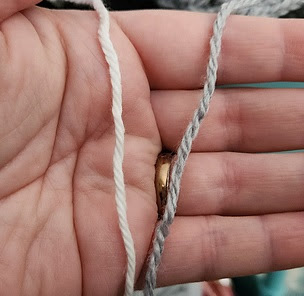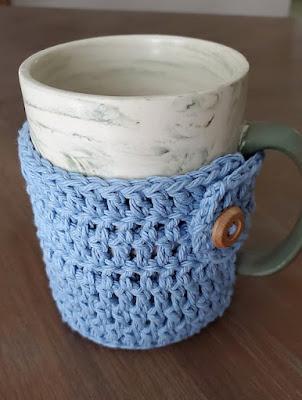About 10 years ago I discovered a lovely pattern for a V-Stitch Headband by JuliChu Crochet. JuliChu had a pattern page for it on Ravelry, which linked to the actual pattern on her blog site. I made the headband several times, loved it, and then moved on to other things for a while.
In 2019 I decided I wanted to make another one of these headbands, but when I tried to go to JuliChu's blog from her Ravelry pattern page, to my dismay I discovered that her blog had been taken down. NOoooOOooOOOooo!!!
Long story short: I learned from this experience that if I ever again find myself in love with a pattern that's only available on the designer's blog, I will always download a copy of the instructions to keep in my personal files, just in case. But I hadn't done that with JuliChu's V-stitch headband pattern.
I reached out to
manmadecreationz on Ravelry, since he had
project pages showing that he had also made JuliChu's V-stitch headband many times, with the hope that maybe he had been smarter than I and had downloaded a copy of JuliChu's pattern. Alas, although he replied to my message and thought that perhaps he might have a copy of the pattern saved, which he would share with me if he could find it, he never got back to me with the actual pattern, so I had to conclude that he hadn't downloaded it either.
I even tried using the Internet Wayback Machine to see if it would recover the pattern page from Juli's blog, but no luck there, either.
It took me a few more years to find the time (and many failed attempts) to try to re-create JuliChu's design, but I think I just might have finally cracked it. I'm not saying this is an exact replica of JuliChu's design, but after carefully examining the stitches of a headband I made previously from her pattern, I believe this comes pretty close. You can give it a go and decide for yourself.
I like the way the shorter height of the edge stitches (versus the height of the V-stitches in the center of each row) creates a curve in the fabric, which conforms to the roundness of the human head nicely.
In my sample photos, the variegated blue headband is made from JuliChu's original pattern, and the solid blue headband is my re-creation of her pattern. As you can see, the solid blue headband turned out a bit wider than the original. But bear in mind that my original headband has also been repeatedly washed and worn, whereas my new headband is fresh off the hook, so those factors have an effect on the current appearance of the pieces.
This pattern re-creation is dedicated to JuliChu Crochet. We may never
know why she took down her blog, but whatever her reasons, we still love
her brilliant designs and hope to continue sharing them for many years
to come.
JuliChu's V-stitch Headband Re-created
US crochet terms
5mm hook
Worsted/aran-weight yarn
Special stitches:
V-stitch: In st indicated - DC, ch 1, DC.
HDC2tog: HDC two together to decrease by 1 HDC. YO, insert hook in indicated st, YO and pull up a loop (3 loops on hook), YO, insert hook in next st, YO and pull up a loop (5 loops on hook), YO and pull through all loops. (1 HDC decreased)
Note: The “ch 1; turn” never counts as a stitch.
Increasing section:
Row 1: Starting with a long (12-14 inches) tail below your slipknot (you can use this length to sew the button on later), FHDC 6. Alternatively, if you don’t like working FHDC stitches, chain 7, turn, HDC in 2rd ch from hook and in each ch to end. Ch 1; turn. (6 HDC)
Row 2: 2 HDC in first st; HDC to end of row. Ch 1; turn. (7 HDC)
Row 3: 2 HDC in first st; HDC to end of row. Ch 1; turn. (8 HDC)
Row 4: 2 HDC in first st; HDC to end of row. Ch 1; turn. (9 HDC)
Row 5: 2 HDC in first st; HDC to end of row. Ch 1; turn. (10 HDC)
Row 6: 2 HDC in first st; HDC to end of row. Ch 1; turn. (11 HDC)
Row 7: 2 HDC in first st; HDC to end of row. Ch 1; turn. (12 HDC)
Now we will begin the V-stitch section:
Row 8: SC in first 2 sts; [V-stitch in next st; SC in next st]. Repeat [] to last 3 st; SC in each st to end of row. Ch 1; turn. (8 SCs and 4 V-stitches)
Row 9: SC in first 2 sts; V-stitch in next SC; [SC in next ch space from V-stitch in row below; V-stitch in next SC from row below]. Repeat [] until last V-stitch and 2 SC remain from previous row; SC in ch space of V-stitch, SC in last 2 sts. Ch 1; turn. (8 SCs and 4 V-stitches)
Repeat row 9 until headband length measures about 18 inches from the first row (unstretched), then begin decreasing section. Even better: If you have the intended wearer’s head circumference measurement, use that to determine how many times to repeat row 9 before working the decrease section. The length of the initial increasing section you made will be about the same as the length of the decreasing section. Therefore, to estimate the total length of your headband (before you work the decreasing section) add the length of the increasing section to the total length you have, and compare that to the wearer’s head measurement to determine when you should begin working the decreasing section. Keep in mind that the headband will stretch a bit when worn, so if you want the headband to fit snugly, aim to make the total length about 1 inch less than the wearer’s head circumference.
Decreasing section:
Row 1: Working ONLY into the SC and ch-1 spaces of the previous row, HDC in each st across. Ch 1; turn. (12 HDC)
Row 2: HDC2tog over first 2 sts; HDC in each st across. Ch 1; turn. (11 HDC)
Row 3: HDC2tog over first 2 sts; HDC in each st across. Ch 1; turn. (10 HDC)
Row 4: HDC2tog over first 2 sts; HDC in each st across. Ch 1; turn. (9 HDC)
Row 5: HDC2tog over first 2 sts; HDC in each st across. Ch 1; turn. (8 HDC)
Row 6: HDC2tog over first 2 sts; HDC in each st across. Ch 1; turn. (7 HDC)
Row 7: HDC2tog over first 2 sts; HDC in each st across. (6 HDC) Do not ch 1-turn. Instead, we will now make a chain space for the buttonhole. Ch 4; turn. Join end of ch to top of 1st HDC of row 7 with a sl st. Ch 1; turn.
Edging: Now we will work a row of HDC around the entire headband to give the edges a clean, finished look. Begin by working 10 HDC in the ch-6 space for the buttonhole. Continue working HDCs around the sides of the headband, placing stitches as evenly as possible. When you get to the “corners” at the end where the project began, work 2 to 3 HDCs in the corners. When you have worked all the way around back to the start of the HDC edging stitches, join using the invisible join method and finish off. (On my sample, I got 8 to 9 HDCs along the side of the increase/decrease sections and 46 HDCs along each side of the V-stitch section.)
Use the long starting tail to sew a 1-inch button on the end opposite the buttonhole, weave in ends, button the headband closed, and enjoy wearing your new headband.
















































